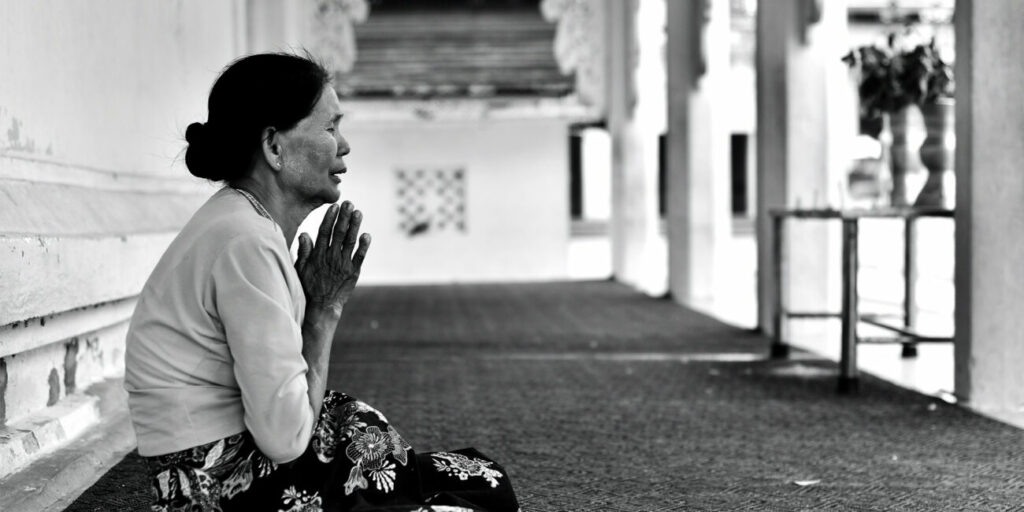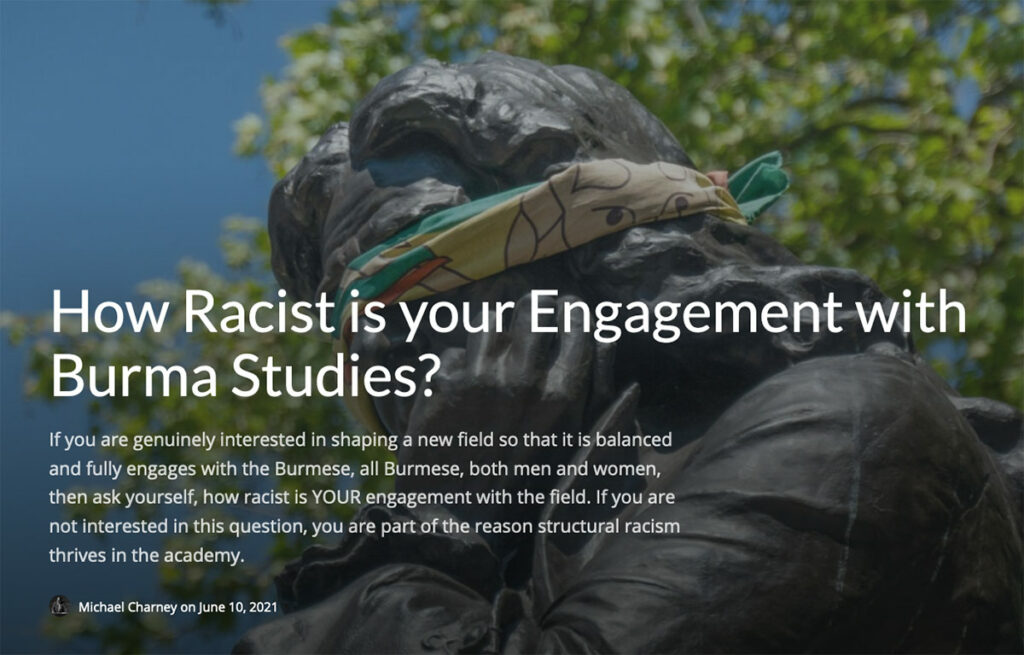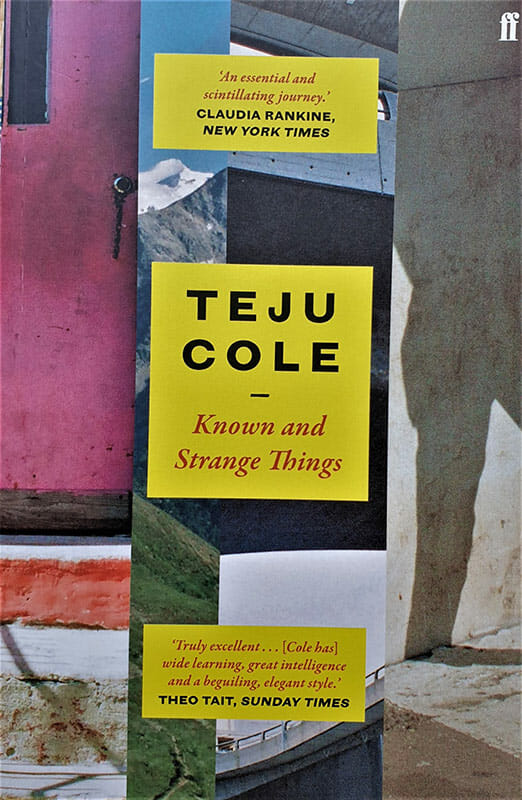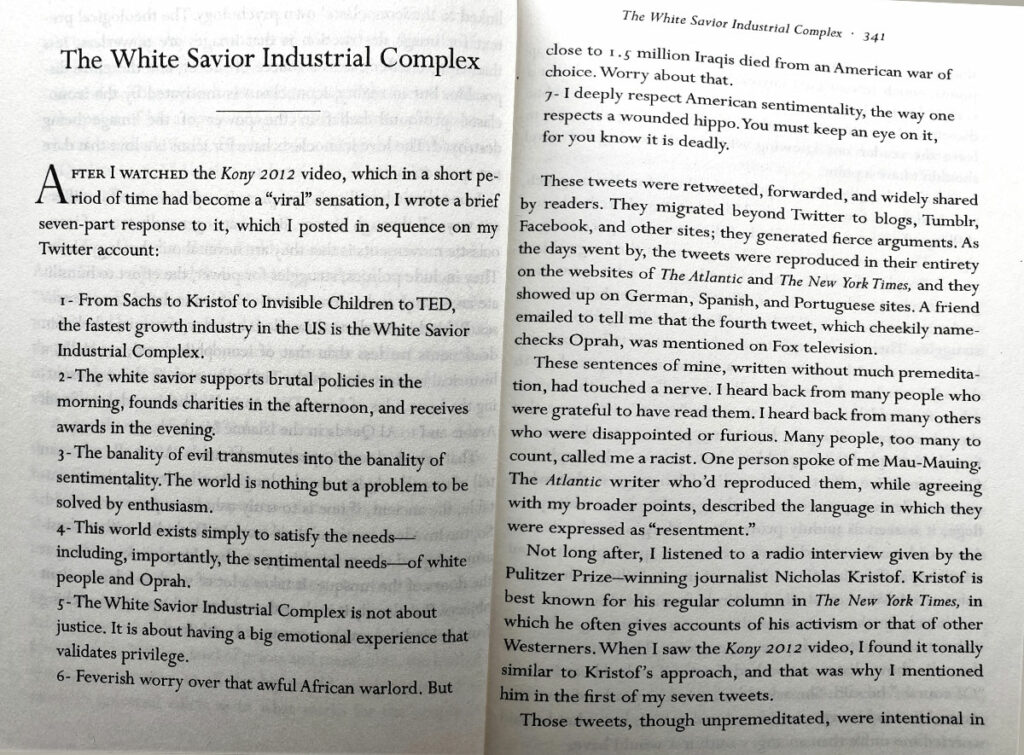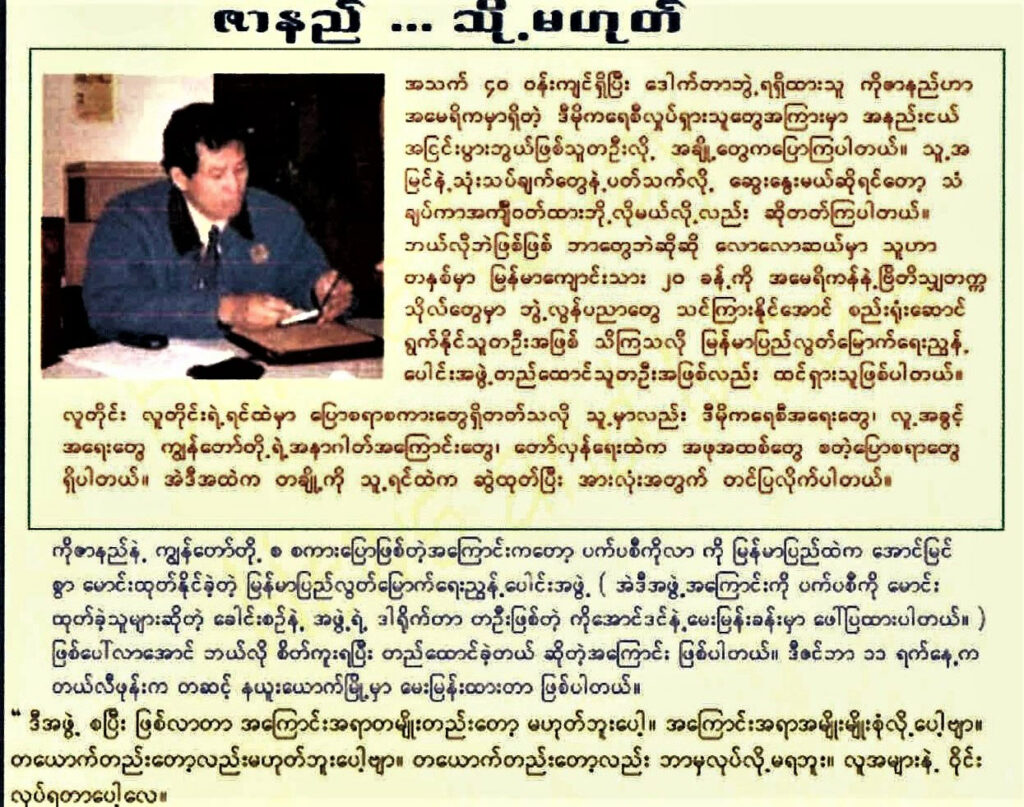Transnational Activism vs White Saviourism in Myanmar Affairs
TRANSCEND MEMBERS, 23 Aug 2021
Maung Zarni | FORSEA – TRANSCEND Media Service
As a Burmese who has been angry – very angry – for decades over numerous forms and countless instances of oppression and injustices in Myanmar, and emphatically, around the world, I am less concerned about the morally corrupt desire of revenge and vengeance of the oppressed towards their oppressor or the System than the enveloping White Saviourism with its corrupting coloniality.
18 Aug 2021 – The images from Kabul will haunt the world for decades while the good people of the West will feel ashamed of their government’s colossal mistakes. What is less discussed and covered in the 24/7 news coverage of the unfolding events in Afghanistan is the collapse of the White Saviour Industrial Complex alongside the regime of President Ashraf Ghani, the American puppet.
Transnational activism is a time-honoured tradition wherein individuals and groups publicly stand with communities of resistance half-way around the world, offer material support (arms, tech, funding, ideas, training, etc.) and otherwise assist those struggling against political repression – all as acts of solidarity.
But, when do human acts of solidarity become, counter-productive and unconsciously colonial and cliquey or “mafia”-like? In what ways does well-meaning activism morph into something nefarious, insidiously colonial or Orientalist? How and when do such acts reproduce colonial relations, with catastrophic consequences?
Transnational Activism is not White Saviourism
Historically many external transnational actors are well-meaning, feel compassion for Fanon’s “Wretched of the Earth”, and speak out or join the fight against the oppressors such as slave-traders and owners of the Old Europe, or colonizers of all stripes and colours to-date. Contemporaneously, this is also the case. Typically, this support has been given in the name of abolition, representative government, “the rights of man”, national liberation, and post-WWII, civil rights, human rights, and democracy. The acts of solidarity have occurred across “the colour lines”, and amongst the celebrated ones are Tom Paine, John Brown, MLK Jr, Che and Castro, Joan Baez, Desmond Tutu, just to name a few.
The solidarity of the anti-Empire radicals on the fringe of Britain’s Left, going back to Sepoy’s rebellion in colonial India of 1850’s, is a subject of Priyamvada Gophal’s critically acclaimed Insurgent Empire by Priyamvada Gopal. The reviewer Miles Taylor (“A superb study of anticolonial resistance”, The Guardian), however, questioned the significance of Gophal’s radical fringe in the “Mother Country”, when he pointed out that “British radicals have always been more comfortable opposing war than empire.”
The same can be said about the pro-human rights organizations, liberal or conservative that arise out of Western institutions and agendas, for example Human Rights Watch or Amnesty International. Such organisations can be characterised as “white saviour” groups. Politically un-prepared to distinguish between human rights as foreign policy and human rights as a set of fundamental values that have to be lived, the world’s leading watchdogs fail when they generally stay within the lobbyist’s comfort zone of what is deemed acceptable in the corridors of power in the global North.
Nowhere is this more evident than in the case of the Rohingya Genocide in Myanmar. These organisations based in London and New York have chosen, for example, not to rock the “no genocide” boat of powerful states that dictate what goes on in the most powerful inter-state bodies such as the Security Council. While scathing and loud in their chorus against the rogue regime in Myanmar, their lack of intellectual and moral conviction has prevented them from calling genocides genocide – from Rwanda in the 1990s to today’s Myanmar.
But there is also a qualitatively different type of “white actor.” These actors see the larger colonial picture and throw in their lot with the oppressed. Nell Irvin Painter, professor emerita of history at Princeton University and the author of The History of White People, writes in the New York Times op-ed “What is whiteness”, “in the 19th century, abolitionists like William Lloyd Garrison and John Brown helped end slavery. In the early 20th century, Mary White Ovington helped found the N.A.A.C.P.”
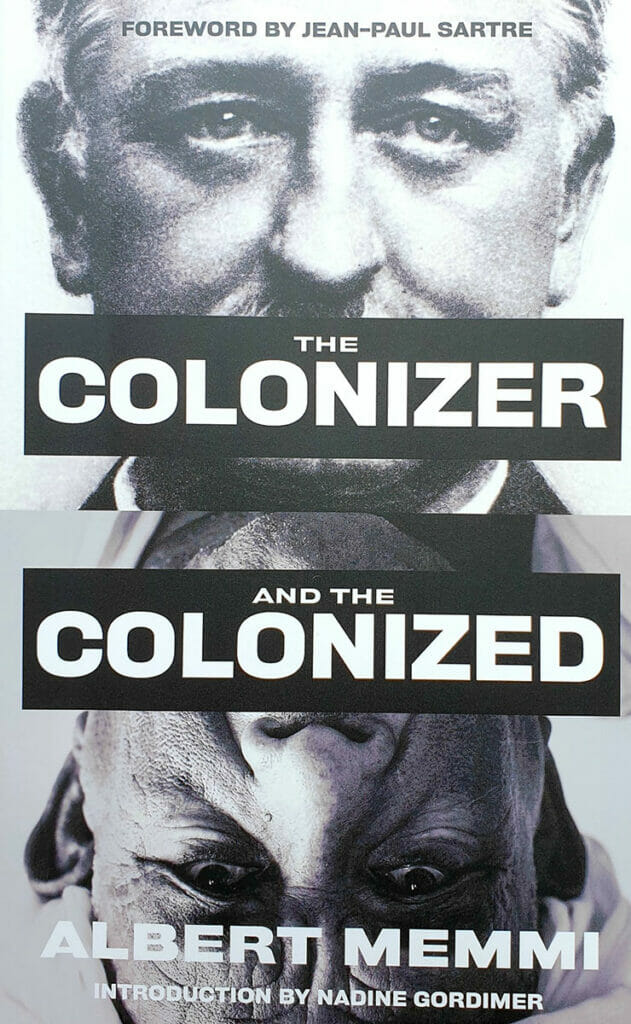
The Colonizer and the Colonized, a nonfiction book by Albert Memmi, published in French in 1957. The work explores and describes the psychological effects of colonialism on colonized and colonizers alike.
Writing from within her African context, in her 2003 critical introduction to Albert Memmi’s “The Colonizer and the Colonized”, a foundational text in Post-Colonial Studies, South African activist and writer Nadine Gordimer stressed that “(m)en and women from leftist colonial (white) backgrounds in South Africa were imprisoned, as Nelson Mandela and thousands of his fellow black South Africans were. Or they were tortured, as Steve Biko was, for taking part in liberation movements.” In responding to the work of Memmi, she rejected the “summary dismissal of the (white) Left in liberation from colonial regimes.” Fair enough.
In the above-mentioned New York Times essay “What is whiteness?”, Princeton scholar Painter argues that “(c)onstructions of whiteness have changed over time, shifting to accommodate the demands of social change. Before the mid-19th century, the existence of more than one white race, (made up of “superior” and “inferior” white races), was commonly accepted, in popular culture and scholarship”.
For the purpose of this essay, I will use Judith Butler’s contextualized contemporary definition of “whiteness” offered in her New York Times conversation with George Yancy, a professor of philosophy at Duquesne University and author and editor of “Black Bodies, White Gazes” and “Look, a White!” Throughout this article I refer to white not as a skin colour but as a form of social power that “reproduces dominance in explicit and implicit ways.”
To Yancy’s probing question, “Do you also see whiteness as “a stylized repetition of acts” that solidifies and privileges white bodies, or even leads to naïve, “post-racial” universal formulations like “all lives matter”?”, Butler replied, “Yes, we can certainly talk about “doing whiteness” as a way of putting racial categories into action, since whiteness is part of what we call “race,” and is often implicitly or explicitly part of a race project that seeks to achieve and maintain dominance for white people. One way this happens is by establishing whiteness as the norm for the human, …” Butler continues, “Whiteness is less a property of skin than a social power reproducing its dominance in both explicit and implicit ways.
Butler-Yancy conversation was based on the tortured race relations in American society in particular. My own FORSEA colleague Michael W. Charney of SOAS, offered a more specific take on the enduring phenomenon of those who do “white saviourism”, based on his honest reflections and observations on race-relations in the international context, particularly area studies in the academy in USA and Myanmar-focused human rights campaigns.
Charney writes, “(m)y view of a white saviour is someone who seeks to compensate for their own inadequacies by trying to work out a sense of moral or political sense of superiority in a non-white society by presenting themselves as a leader of some kind. This is the opposite of trying to empower non-white people and their voices. It is instead just another way to disempower and silence them and place the attention firmly on the white saviour. The main benefit intended is always for the latter, to self-empower and gain a status they could not achieve in their home society, to purge their guilt and compensate for their sense of inferiority, and to exploit the resources, material and intellectual, of non-white society. They want a colonial relationship in a postcolonial world and hide the whip in their back pocket.”
The Road to New Orientalism runs through “Human Rights mafia.”
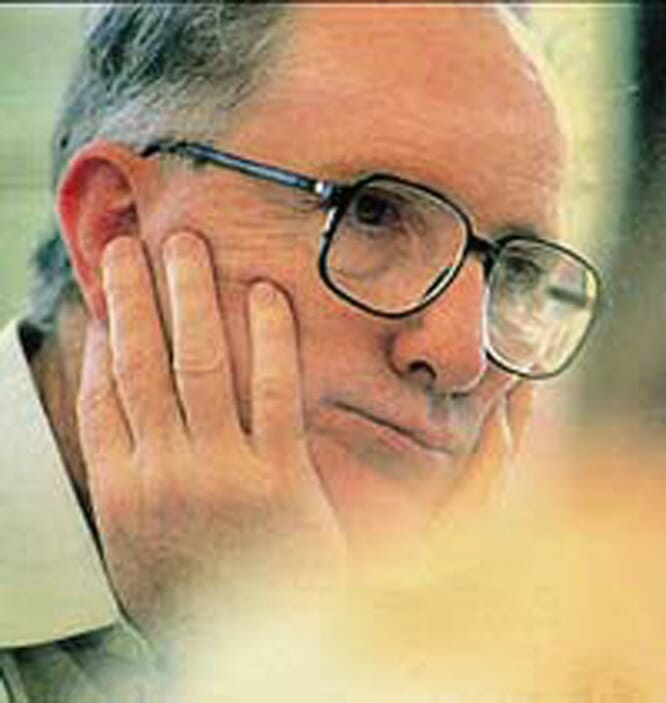
Jack Healey, an American human rights activist, alled “Mr. Human Rights” by U.S. News and World Report, Healey’s focus has been on inspiring the youth to support non-violent activism that would push back oppressive governments and societies. Wikipedia Commons
In our private conversations, Jack Healey, the renowned human rights campaigner who headed Amnesty International/USA for 12 years in the 1980’s, typically characterises, tongue-in-cheek, as “human rights mafia” the lobby-focused human rights watch dogs such as Human Rights Watch and his old outfit AI/USA.
Against this characterization of influential US-UK-based human rights organizations, the vexing questions that have, however, pricked my mind for so long is this: When do human acts of solidarity become, counter-productive and unconsciously colonial and cliquey or “mafia”-like? In what ways does well-meaning activism morph into something nefarious, insidiously colonial or Orientalist? How and when do such acts reproduce colonial relations, with catastrophic consequences?
The critical insight which Judith Butler, the renowned scholar in critical theory and comparative literature at UC Berkeley, offered, in reference to the production and reproduction of racism in USA through daily social and institutional relations is applicable to (white) racism – interchangeably Orientalism – in the international human rights world. Butler writes, “racism has complex origins, and it is important that we learn the history of racism to know what has led us to this terrible place. But racism is also reproduced in the present, in the prison system, new forms of population control, increasing economic inequality that affects people of color disproportionately.”
Here Gordimer is spot on when she took aim at the continuing colonial nature of the world’s economy. She writes, “(w)hat the original liens of colonialism established in trade are worth in post-colonial times, is plenty. There are former colonies whose natural resources, from cocoa to gold, are still bought low and sold high. One of globalisation’s immense tasks is to serve as the means of tackling this final form of colonialism. And it cannot be done for the developing countries that once were colonies (supposing there would be the will to do so …), but must be done with them, in full recognition of their essential place in policy decisions” (p.43, italics original).
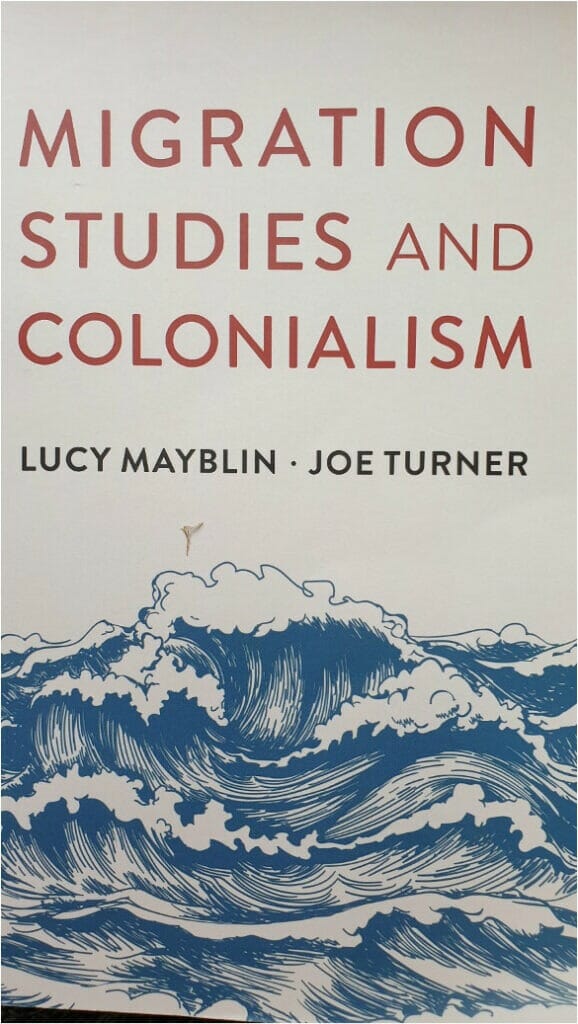
Migration Studies and Colonialism, Lucy Mayblin, Joe Turner, Polity Press
“The Global Mobility Divide” and “Temporal White Spaces”: Foundational Pillars of the White Saviour Industrial Complex
The well-known aphorism, ‘we are here because you were there’, was coined by the late Director of the Institute on Race Relations of UK, A. Sivanandan. He, explained only 50% of the the post-colonial causal relations between post-Raj Britain’s migrants of colour from former British “possessions and the British state, the “Mother Country” that colonized foreign populations, grabbed their land, exploited anything of commercial and strategic values and disrupted lives and communities. This applies equally to present-day economically and geopolitically driven foreign policies of Europe and N. America. Resource extraction such as oil and gas, for instance, has wreaked havoc around the world, facilitating the displacement and triggering the outflows of millions of humans seeking refuge in the rich white world of the Global North or the West.
Drillers and extractors, “are still there” in resource-rich Africa, Asia, and the Middle East, but they do not want our brown and black bodies to seek refuge on the shores of Europe. The threat of Communism is no more. But typical foreign policy of western governments dictates that refugees, migrants and asylum-seekers must be contained. A well-documented case is Sudan’s ex-genocidal militia – known as Janjaweed. The group was – reincarnated by Sudan in 2014 as “Rapid Support Forces”, with EU political endorsement and millions of Euros as part of migration management and EU border control programmes. (See “‘Border Control from Hell′ report targets EU funding in Sudan”, DW 06.04.2017. ) In the post-Brexit United Kingdom, the British Home Secretary Priti Patel, a child of immigrants from Africa herself, is pushing to even criminalize humanitarian assistance to any asylum-seekers while unlawfully “trying to evict thousands of migrants during the pandemic despite the risks to the communities they live in from doing so.”
There’s another part to Sivanandan’s aphorism, which he did not mention. The white western bodies roaming around the coloured world of the wretched is not a historical accident. For example, well-meaning, liberal or “compassionate conservative”, globe-trotting, Myanmar or Asia-bound white saviours raise their pro-human rights voices, as free-lancers, philanthropists, government “donors”, volunteers, interns, advisers, “capacity-builders,” INGO researchers, and so on. Hundreds take up residence in places like Yangon, Kuala Lumpur or Bangkok. Some “go native” and throw in their lot with the wretched. Meanwhile others parachute in as gurus of peace-building and development, rule of law consultants, or “star academics”, pursuing their divergent “missions”, “assignments” or “field work”. They render the lives lived by the wretched into temporal “white spaces”.
Travel is one-directional from the centres of global power to Myanmar to extract and produce knowledge about the brown world. Burmese do not occupy the same the old or new white centres of wealth and power in the West. They do not arrive as “Britain-watchers”, or expert commentators on USA or European affairs. This is a prominent feature of the nominally post-colonial world, which remains foundationally colonial in essence, structure and practices. None more so than in the practice of knowledge production. In his provocative essays “How Racist is your Engagement with Burma Studies? | FORSEA “ the American scholar of Southeast Asia Michael W. Charney of SOAS took aim at “the white academy” of the West and the colonial root of the region’s centres of knowledge production, that is, the universities. State-Think and the Problem with University Education in Post-Colonial Societies.
In his essay “The White Saviour Industrial Complex” (Known and Strange Things, 2016, p.345), Teju Cole, the American writer of Nigerian origin, wrote, matter-of-factly, “a nobody from America or Europe can go to Africa and become a godlike saviour, or at the very least have his or her emotional needs satisfied. Many have done it under the banner of ‘making a difference’. To state this obvious and well-attested truth does not make me a racist.” Ditto that in Myanmar affairs.
Known and Strange Things (faber & faber). The first collection of essays from Teju Cole, writer, photographer and professional historian of early Netherlandish art
In the jargon of Migration Studies, “the Global Mobility Divide,” wherein the world is made “a small village” which exclusively opens the gates for those (Whites) with their “highly ranked” passports is one foundational factor that has long facilitated the emergence of the latter-day version of the old Europe’s Civilizing Mission – or Cole’s “White Saviourism”.
White people are aware of consular representation or access, if they have a brush with local law in countries of the Global South, or possibility of a medical airlift out of Trumpian “shithole countries” back to Euro-American homes if their tummy aches worsen, or they can get on their embassy-organized chartered flights when the brown people’s conflicts show signs of engulfing their white lives be it Kabul, Afghanistan this week or Saigon, Vietnam of 1977.
Irrespective of the white saviours’ noblesse oblige (or the privileged responsibility of noble obligation), which White saviours may personally experience, the coloniality of this mobility divide is a priori at work in the world of international human rights. Just as Cole’s scathing tweets about the white saviourism does not make Cole a black racist” – an oxymoron anyway! –, belabouring this obvious point does not make me a racist or human rights reactionary. Colonial relations are to be exposed and resisted, whether they developed in Orwell’s Burma of 1920’s as he did brilliantly in his first novel “Burmese Days”, or in today’s human rights INGO-ism and Myanmar policy affairs.
Albert Memmi was a Sorbonne-trained philosopher and activist. In his 1957 publication of The Colonizer and the Colonized with Satre’s introduction, he stirred up the debates about dependency between the colonizer and the colonized based on his own personal experience as a Tunisian Jew who sided with Muslims against the French colonizers. the Afterwards, in his 1967 preface, he conceded that his book contains “scandalous content”.. I happily invite new waves of scathing slanders and attacks against me for causing yet another “controversy” in the world of Myanmar affairs by labelling well-meaning whites as the usurpers of Burmese voices, the gate-keepers, content-managers and censors, and controllers of policy recommendations and advocacy soundbites.
Being Good and Doing Good in a Bad Colonial World: Memmi’s Usurpers and Myanmar Policy Advocacy
In her rather thought-provoking piece in the Boston Review, The Philosophy of Anger (April 2020), Agnes Callard, the Berkeley-trained scholar of ethics and ancient philosophy pointedly argued that “We can’t be good in a bad world.”
Indeed you can’t be good colonials in Gordimer’s “post-colonial” colonial world, even with your new Message of Salvation, that is, human rights as an elastic and compromised element of western Foreign Policy vis-à-vis a set of lived, inalienable values.
Remember “Civilizing Mission”?
Let’s for a moment suspend this big-picture Global Mobility Divide. This global predicament, no radicals or revolutions can rectify overnight – if at all. And let’s make a hypothetical moral case for today’s transnational human rights activism.
Surely, the educationally deprived, half-starving, and now Covid-stricken Burmese, dissidents and average Joe alike, must welcome any kind of support and assistance, (intellectual, strategic, moral, psychological, institutional and so on), that any well-endowed and well-placed organizations are prepared to offer as we/they (the Burmese) struggle or simply long for the rights of humans, freedoms from our homegrown military tyranny, an advancement of our career or simply a decent life in this big bad world.
Correct, up to a point.
The “Correct” ends where the acts of “privileged white helpers” render Myanmar’s wretched agency-less. It ends when these helpers inject their white agendas or white contents in the form of scripts and talking points for the locals, desperately seeking a microphone or a platform. Unequivocally, the “Correct” or my own “correct!” ends when the white helpers or supporters – in unequal personal and organizational power relations – begin acting like Usurpers. There is no such thing as a good colonial, despite his or her desire for the salvation of oppressed.
In The Colonizer and the Colonized, Albert Memmi identified three factors – profit, privilege and usurpation – that typify the colonizer. In the 21st century of international law, new colonies, be they textbook White Settler countries like those of north America and Australia, or classical Raj of the bygone era, are no longer conceivable.
But what I call “global White Spaces” – with the capitals W and capital S – retain the residual symptoms of the Old World. In the Old World genocidaires, plunderers, landgrabbers and so on have often been framed in the media or school curricula of the formerly colonial West –as “explorers” “adventurers” or “discoverers” – of whom Columbus of Genoa (present-day Italy) is only the most infamous.
Thanks to “the Global Mobility Divide” (See Migration Studies and Colonialism. 2021), “the human rights mafia” – again to borrow a rather apt label coined by my old friend Jack Healey of Washington DC with half-century of deep involvement in global human rights and peace activism, the web of personal ties, funds, access to power, propaganda machinations, and certain buzzy political lingo, are intricately linked. The White Spaces such as human rights, peace and democracy fora are abuzz with initiatives labelled “capacity building”, “empowerment” “brainstorming” or “partnership building,”. These spaces assume the forms of academic panels, press conferences, NGO meetings, congressional or parliamentary hearings, fieldwork, policy retreats and advocacy meetings. Many are ultimately geared towards influencing the proceedings and policy debates within the inter-state and state bodies (for instance, UN and European Union or influential national governments or Congress/Parliament such as the United States and United Kingdom).
What acutely concerns me is not so much the profits and privilege of the whites, (the first 2 of the 3 factors Memmi identified as features of the colonial relations), as the vicious and recurring pattern of numerous acts of usurpation.
These acts of usurpation as part of the White Saviour Industrial Complex in Myanmar emerged from the presence of INGOs, freelancers and professionals on the Thai-Burmese borders a quarter century ago when thousands of Burmese activists fled the cities to the rebel-held border regions following the bloody crack-down of their nationwide uprisings by General Ne Win’s military dictatorship. Two decades on, this complex in Myanmar affairs shifted itself inside Myanmar, to accompany the military’s sham processes of “democratisation” and “development” over the past decade. My American colleague, SOAS Professor Michael W. Charney, characterises this usurping as “carpet-begging”.
The white domination of Burmese spaces of resistance has multiplied, like an invasive plant species. Burmese modes of resistance and affecting change in their own troubled country are suffocated by international Myanmar policy discourses centring around humanitarian assistance, disaster relief, human rights and democracy, peace building and development.
Have a glance at the above tweets by Teju Cole, which have been critically acclaimed by some and labelled as “racist” by others. Tweet One: “From (Jefferey) Sachs to (Nicholas) Kristof to Invisible Children to TED, the fastest growth industry in the US is the White Saviour Industrial Complex.” Well, this complex has no borders, and USA may be the home of the biggest juggernaut; but, Europe with its focus on exporting “peace”, “development” and “humanitarianism” is no less important.
His other insightful tweets read: “this world exists simply to satisfy the needs – including, importantly, the sentimental needs – of white people and Oprah (Winfrey). White Saviour Industrial Complex is not about justice. It is about having a big emotional experience that validates privilege.”
Against the backdrop of the celebrated “Myanmar Spring”, I had written a chapter-length essay “Orientalisation and Manufacturing of ‘Civil Society’ in Contemporary Burma” (2012) on the subject of how powerful and well-endowed Western actors have manufactured their civil society (that is, a network of local elites friendly to western corporate interests and pliable to the honey-tongued dictates of “western donors”). Emphatically, the institutionalized White Saviourism goes beyond the Colean sentimental needs of individual whites.
Intruding Brown Bodies in White Spaces
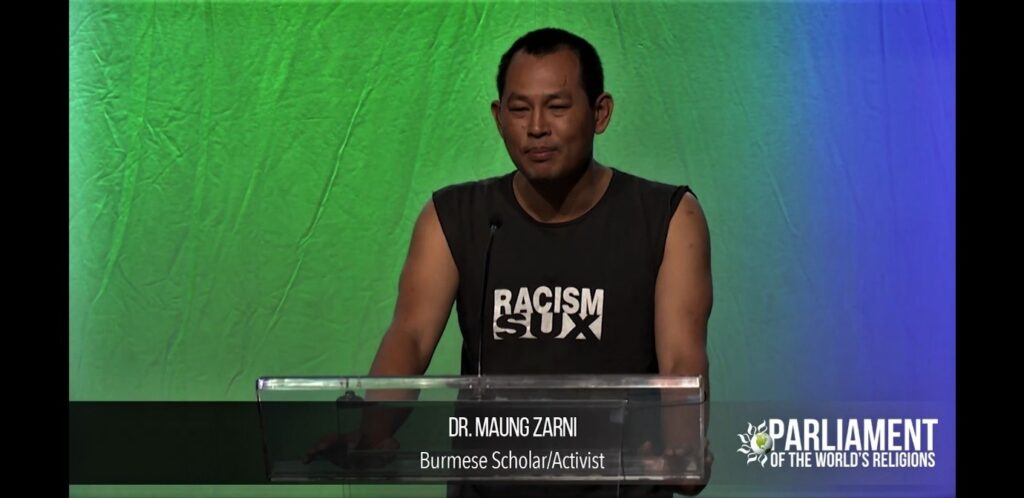
Zarni speaking on the failures of the international community in Myanmar genocide, theBi-Annual Conference of the Parliament of the World’s Religions, Salt Lake City, Utah, USA, Oct 2015
Throughout my three decades of doing transnational activism around Myanmar, I have seen up-close and personal how the white saviours of Cole’s Complex engage in numerous acts of usurpation.
To give an example – among dozens of tales I can recount – I have seen and known first-hand, a year after I started my American schooling at the University of California at Davis 32 years ago, I attended an NGO- event organized by the Rain Forest Action Network (RAN) and some other human rights NGOs. At the event, the Burmese were relegated to sit in the audience while the White campaigners – a white American female lawyer and the director of RAN, a white American male campaigner, explaining what life and the Environment were like for the Burmese. We were apparently the subject of their charitable intellectual expositions. Never mind that that the Bay Area is one of the world’s largest pockets of Burmese emigres and immigrants, including older generation exiled dissidents who knew a thing or two about the repressive military’s political economy and policies and practices.
Apparently, like fish in the water unaware of their medium, neither the two American speakers nor the event organizers were conscious of this latter-day colonial absurdity wherein the Burmese were rendered “subjects” of the discussion, but had no space other than to ask questions politely, when requested, during Q and A.
Finding the Kafkaesque situation unbearable, I walked up to the white-only panel from my seat, inserted myself at one corner and, standing, offered my more textured take on our country’s sordid affairs, in my “English (as a Second Language) with Ngapi or fish paste accent”, as we mock ourselves. Alas, an intruding brown body in reserved white space! I sensed that I had made the two American speakers and the event organizers feel uncomfortable. That was indeed my first act of rubbing white usurpers the wrong way, in retrospect. But is this still relevant 32 years later? Despite the brown tokenism on panels and in the media, yes I think so.
The intrusions, disruptions and irreverential behaviour of mine in Global White Spaces have since become a subject of disdain among the international world of Myanmar affairs.
I confess that I am a repeat offender in these circles of intellectual influence, social respectability or state power. In other words, I rub many a White Saviours the wrong way.
In the later 1990’s, I vividly remember telling the Clinton Administration officials that the Burmese lives, murdered, maimed or tortured, were not just stats, at a meeting in the West Wing. In attendance were the Director of Asia on the National Security Council whose name has since faded from my memory and the then Presidential speech writer Tom Malinowski (now US Congressman after having worked as Washington Director of Human Rights Watch and US Assistant Secretary of State on Democracy, Labour and Human Rights Affairs at the US State Department).

Gayatri Chakraborty Spivak, delivering her keynote address at the Berlin Conference on Rohingya Genocide, The Jewish Museum of Berlin, Germany, February 2018.
Habitually, I began exposing what Gayatri Chakraborty Spivak calls the “sanctioned ignorance” of the colonial white world, which in the words of Spivak, is “inseparable from colonial domination.” Sanctioned Ignorance – GLOBAL SOCIAL THEORY I have indeed sinned by “spoiling” the white saviours’ “big sentimental experiences” and disrupting their moments of intellectual ignorance and moral self-gratification, the very subjects of Teju Cole’s scathing tweets: I call them out on their discernible internalized “Orientalism”, or worse.
My sole guiding motto has been “Thou shall not validate the white privilege nor succumb to the conditioned brown, yellow or black sensitivities towards what has come to be diagnosed as “White Fragility.”
Myanmar’s “Great Opening” of 2010 was lauded by the then President Barack Obama “an extraordinary transition”. He suggested it was something which Iran and Democratic People’s Republic of Korea (N. Korea) should emulate. (Incidentally, Obama has not even fired a single tweet of concern since Feb 1st, when the country moved from genocide to the coup to “anarchy” as the Washington Post editorial put it.) Meanwhile, the Myanmar White Saviour Industrial Complex has forged an ever-expanding circle of Memmi’s inter-generational Usurpers. Tony Blair and his team are amongst the crowd, having migrated from other world’s “hot spots” and other “hardship postings” of the Middle East and Africa. I have heard tales of the new Burmese Days as veterans of the old Free Burma campaigns mingle with the new Myanmar Spring crowds. The grey eminences of Burma Studies who have for half-century or so served as gatekeepers, are grooming new crops of white scholars and vetted brown bodies. Those brown bodies are Myanmar scholars, who are sufficiently deferential towards the established Epistemological and Academic Order of the field and grateful towards their individual white patron-academics.
The State of Myanmar Human Rights Advocacy: Progress?
Infused with the new generation’s ideas – gender equality, optics, agency, etc. – their methods of running the White Saviour Industrial Complex have changed with the times and are infused with more progressive norms. Or are they?
The Old Myanmar hands in the complex now pay close attention to identity-politics and are sensitive to the need for managing optics. After all, in the social media age, images and words travel instantaneously. No reputable leading human rights groups or lobby network desires bad PR.
During the 1980’s and 1990’s, Burmese refugees, particularly females, were brought into the corridors of power – US Congress, British parliament, etc. – where, clad in their colourful native attire, they routinely used tear-jerking narratives designed to reinforce that the West should “do the right thing”. These Burmese brown bodies may be informed about the gross violations of human rights or international criminal law (for instance, war crimes or convention against torture) by British and American governments, but they (the Burmese) stick to the script designed to reinforce and appeal to the collective sense of moral power in white spaces..
Alas, the victims of egregious violations of universal human rights help momentarily to fulfil, wittingly or not, the collective and individual “sentimental needs” of the white saviours as the victims and their representatives appeal for the Salvation of brown bodies half-way around the world. Then come white scholars, experts and NGO personnel who would offer policy recommendations and country analyses based on field trips and human rights research.
The Browning of White Messages of Salvation
Those tear-jerking days are gone, along with the bad optics. Now we are typically treated to the sight of brown Myanmar bodies – gender-balanced, often – billed as “authentic” voices of the oppressed, who not only tell their sorrowful tales as Myanmar activists but also suggest what needs to be done.
I can’t help but notice the emergence of new phenomenon which I call “browning the policy templates” or scripting the victims’ policy advocacy narratives.
Carefully vetted brown bodies – the Burmese, ethnic minorities, the Rohingyas, the Muslims, the refuges, the former political prisoners, the exiles – have become the vehicles to convey and reinforce (white) INGO-pre-determined messages. That is, with one caveat. The chosen ones among the Burmese need to be prepared to stay within the discursive parameters which will come across as “not too radical” to power. This vetting process is typically the job of the White Saviours – NGOs, government advisers, Congressional aides, who serve as the first line of sanitizers in these corridors of power.
Year in and year out, the latter will dutifully deliver the browned policy messages at various international fora – including upon occasions at the Security Council and seasonally at the United Nations Human Rights Council sessions and side-events, with their scripts littered with technical buzzwords – “COI” (for Commission of Inquiry), “targeted sanctions”, “arms embargo”, “transitional justice”, “accountability” and so on and so forth.
At a glance, many of these jargons sound sensible. The sound-bites may even come across as smart, strategic and moral. But the fact that they are put in the heads of the chosen few among the millions of the wretched, and in some cases, even against their better judgment – to be regurgitated through brown mouths is a fundamentally colonial act. Most certainly, the late Memmi would call this act of usurpation.
In his 18-minutes conversation with a Danish interviewer, the renowned Kenyan writer and anti-colonialist scholar, Ngugi wa Thiong’o, talked about how the process of domination and subjugation involves supplanting memories of the dominated in the context of both the African slavery, which most White European powers – not just the usual suspects of the old France, Britain, Spain, Portugal, and Netherlands, but also Sweden and Denmark, much-lauded today for their “heavenly” social democracies. (See this 18-minutes interview at ABOUT – Ngugi wa Thiong’o.)
Here I would extend and apply Ngugi’s insight into the realm of today’s global human rights advocacy world: white saviours typically “pour” their preferred slogans and policy templates into the heads of the “spokespersons” for the wretched of Myanmar. The Burmese who are elite enough to speak English and fluent in human rights jargon are expected to reproduce the soundbites of recommendations or analyses.
Here I will tell a tale which I know first-hand and as a matter of fact.
In 2018 I attended a 3-day NGO workshop organized and hosted in a 4-star hotel in Kuala Lumpur by a reputable American and Swiss-registered NGO with the avowed aim of building human rights movements in Southeast Asia.
Who is who of the Rohingya genocide campaign – Human Rights Watch, a few representatives of some American philanthropic foundations, Rohingyas and Muslim activists from the diaspora and Myanmar, congregated in the hired meeting room at the hotel. In those Rohingya genocide-headlined days, the flavour of international campaigns for the Rohingya was the Commission of Inquiry or COI.
The Burmese and Rohingay were effectively given a crash course on Lobbying-101, with charts, objectives, timelines and all. It turned out that the meeting was not so much the white saviours and the brown brains banging together to develop goals and strategies as it was to brown the predetermined push for the United Nations Commission of Inquiry on Myanmar. The white NGOs used their superior brains and needed the brown mouths and faces who will amplify the main product of their brains: UN’s COI will advance our salvation! Of the 3-days, the last few remaining hours were obligatorily allotted for other items and issues that elite activists – us – among the wretched of Myanmar may wish to bring up.
In another tweet, Cole said ,“the white saviour supports brutal policies in the morning, founds charities in the afternoon, and receives awards in the evening”. This may be modified in Myanmar. It does not wholly apply to the Myanmar-centred White Saviour Complex which take a stance against brutal policies towards Myanmar and adopt victims – or to use today’s language “survivors” who are willing to speak from their policy sheet. These brown men and women are then promoted as “change-makers”, or formally “heroes and heroines”. This began with the now condemned Lady, Aung San Suu Kyi, who was showered with every honour ever invented in modern history.
Read: “From peace icon to pariah: Aung San Suu Kyi’s fall from grace” | Aung San Suu Kyi | The Guardian
Even after the disastrous end of the manufacturing of Aung San Suu Kyi as a global icon of Metta or loving kindness, Gandhian non-violent resistance , and (political and economic) liberalism, the White Saviour Industrial Complex continues to set up unhelpful hierarchies among Myanmar activists. The few chosen Brown speakers in the white spaces of power are answerable to the white NGO management, but not to their own communities of the oppressed.
Moral Corruption of the Elites among the Oppressed: The Hierarchy of Domination
The Complex’s manufacturing of heroes and heroines among the brown bodies of Myanmar by no means is a one-way street. It is a symbiosis of political actors who pursue the separate ends of the salvation pole. On one hand, the white saviours and their networks/organizations need the brown wretched of Myanmar for legitimation purposes – to justify their budgets and branding while maintaining their position at the top of international human rights lobbying pole. On the other hand, the chosen Myanmar activist elites who prove themselves indispensable in the emerging trend of “browning” white messages genuinely want salvation for their communities in wretched conditions. Importantly, they also know that there are competing actors and voices from within their oppressed communities, perhaps with deeper roots in the communities of dissidents, refugees, or genocide victims, that will dislodge them, were it not for the white saviours who give them mic, and frame them as “leaders” or “spokespersons” of the oppressed.
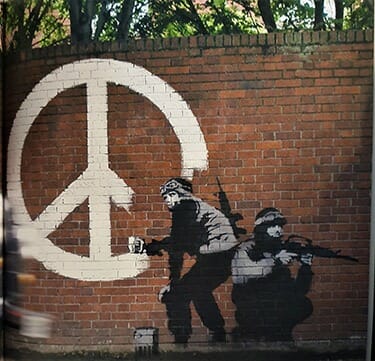 All this in exchange for staying within the discursive policy frameworks or the INGO comfort zones. This sordid fact is not lost on the grassroots communities. The NGO-allied or NGO-promoted brown bodies are generally talked of as taking the “NGO-line”, a term suggesting an element of moral corruption.
All this in exchange for staying within the discursive policy frameworks or the INGO comfort zones. This sordid fact is not lost on the grassroots communities. The NGO-allied or NGO-promoted brown bodies are generally talked of as taking the “NGO-line”, a term suggesting an element of moral corruption.
Since Myanmar emerged from its isolated socialist military dictatorship with the 8 August 1988 uprisings, the country has had one of the world’s largest constellation of celebrated human rights defenders, democracy icons and gender equality advocates, starting with Aung San Suu Kyi. But few have used their white saviour-manufactured international status and fame to shine the light on the darkest spaces in Myanmar – that is genocide, anti-Muslim violence, the systematic use of rape as a weapon of war, or “the pacification” of colonized minorities. Quite the opposite. From “the Lady” to lesser known “human rights defenders” and Amnesty International’s “prisoners of conscience” including the 1988 Generation Group, used their voice to defend and deny Myanmar genocide.
In my own assessment, one must believe in, internalise and live the ideals of human rights, or certain higher principles such as inclusion, multiculturalism gender equality, anti-elitism, anti-racism, anti-homophobia etc. Despite the accolades, most of our human rights “heroes” and “heroines” do not walk the walk of their human rights and equality talk. It is not only the oppressor – the racist genocidal Burmese military leaders and the troops – that have shown moral corruption but also the wretched of Myanmar themselves from the top politicians to elite strata among the survivors of genocide and their White Saviours
Dissecting the moral dimensions of the rage of the oppressed induced by oppression and the natural desire for revenge and retributions, the University of Chicago philosophy scholar Agnes Callard, a Hungarian Jewish philosopher who immigrated to USA as a young girl, wrote in her “The Philosophy of Anger” | Boston Review :
Victims of injustice are not as innocent as we would like to believe. Either these victims are morally compromised by the vengeful and grudge-bearing character of their anger, or they are morally compromised by acquiescence. we are accustomed to the thought that wronging others makes you a bad person. My point is: so does being wronged, even if to a lesser degree.
As a Burmese who has been angry – very angry – for decades over numerous forms and countless instances of oppression and injustices in Myanmar, and emphatically, around the world, I am less concerned about the morally corrupt desire of revenge and vengeance of the oppressed towards their oppressor or the System than the enveloping White Saviourism with its corrupting coloniality.
In his rejoinder to Callard’s criticism directed at the rage-driven moral corruption of the oppressed – they must find the moral way to express their anger – UC Berkeley political scientist Desmond Jagmohan – makes the case for rage of the oppressed: “people owe it to their self-respect to get angry in the face of oppression and to express their anger to others”. And I will give Jagmohan the last word, when he writes
“(m)aybe we should strive harder to think with the oppressed rather than to think for them” (italics & bold mine).
https://bostonreview.net/forum/philosophy-anger/desmond-jagmohan-anger-and-politics-oppressed
___________________________________________
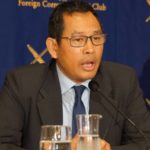 A Buddhist humanist from Burma, Maung Zarni is a member of the TRANSCEND Network for Peace Development Environment, former Visiting Lecturer with Harvard Medical School, specializing in racism and violence in Burma and Sri Lanka, and Non-resident Scholar in Genocide Studies with Documentation Center – Cambodia. Zarni s the co-founder of FORSEA, a grass-roots organization of Southeast Asian human rights defenders, coordinator for Strategic Affairs for Free Rohingya Coalition, and an adviser to the European Centre for the Study of Extremism, Cambridge. Zarni holds a PhD (U Wisconsin at Madison) and a MA (U California), and has held various teaching, research and visiting fellowships at the universities in Asia, Europe and USA including Oxford, LSE, UCL Institute of Education, National-Louis, Malaya, and Brunei. He is the recipient of the “Cultivation of Harmony” award from the Parliament of the World’s Religions (2015). His analyses have appeared in leading newspapers including the New York Times, The Guardian and the Times. Among his academic publications on Rohingya genocide are The Slow-Burning Genocide of Myanmar’s Rohingyas (Pacific Rim Law and Policy Journal), An Evolution of Rohingya Persecution in Myanmar: From Strategic Embrace to Genocide, (Middle East Institute, American University), and Myanmar’s State-directed Persecution of Rohingyas and Other Muslims (Brown World Affairs Journal). He co-authored, with Natalie Brinham, Essays on Myanmar Genocide.
A Buddhist humanist from Burma, Maung Zarni is a member of the TRANSCEND Network for Peace Development Environment, former Visiting Lecturer with Harvard Medical School, specializing in racism and violence in Burma and Sri Lanka, and Non-resident Scholar in Genocide Studies with Documentation Center – Cambodia. Zarni s the co-founder of FORSEA, a grass-roots organization of Southeast Asian human rights defenders, coordinator for Strategic Affairs for Free Rohingya Coalition, and an adviser to the European Centre for the Study of Extremism, Cambridge. Zarni holds a PhD (U Wisconsin at Madison) and a MA (U California), and has held various teaching, research and visiting fellowships at the universities in Asia, Europe and USA including Oxford, LSE, UCL Institute of Education, National-Louis, Malaya, and Brunei. He is the recipient of the “Cultivation of Harmony” award from the Parliament of the World’s Religions (2015). His analyses have appeared in leading newspapers including the New York Times, The Guardian and the Times. Among his academic publications on Rohingya genocide are The Slow-Burning Genocide of Myanmar’s Rohingyas (Pacific Rim Law and Policy Journal), An Evolution of Rohingya Persecution in Myanmar: From Strategic Embrace to Genocide, (Middle East Institute, American University), and Myanmar’s State-directed Persecution of Rohingyas and Other Muslims (Brown World Affairs Journal). He co-authored, with Natalie Brinham, Essays on Myanmar Genocide.
Tags: Asia and the Pacific, Aung San Suu Kyi, Burma/Myanmar, Colonialism, Colonization, Hegemony, Imperialism, Rohingya, White Supremacy
DISCLAIMER: The statements, views and opinions expressed in pieces republished here are solely those of the authors and do not necessarily represent those of TMS. In accordance with title 17 U.S.C. section 107, this material is distributed without profit to those who have expressed a prior interest in receiving the included information for research and educational purposes. TMS has no affiliation whatsoever with the originator of this article nor is TMS endorsed or sponsored by the originator. “GO TO ORIGINAL” links are provided as a convenience to our readers and allow for verification of authenticity. However, as originating pages are often updated by their originating host sites, the versions posted may not match the versions our readers view when clicking the “GO TO ORIGINAL” links. This site contains copyrighted material the use of which has not always been specifically authorized by the copyright owner. We are making such material available in our efforts to advance understanding of environmental, political, human rights, economic, democracy, scientific, and social justice issues, etc. We believe this constitutes a ‘fair use’ of any such copyrighted material as provided for in section 107 of the US Copyright Law. In accordance with Title 17 U.S.C. Section 107, the material on this site is distributed without profit to those who have expressed a prior interest in receiving the included information for research and educational purposes. For more information go to: http://www.law.cornell.edu/uscode/17/107.shtml. If you wish to use copyrighted material from this site for purposes of your own that go beyond ‘fair use’, you must obtain permission from the copyright owner.
